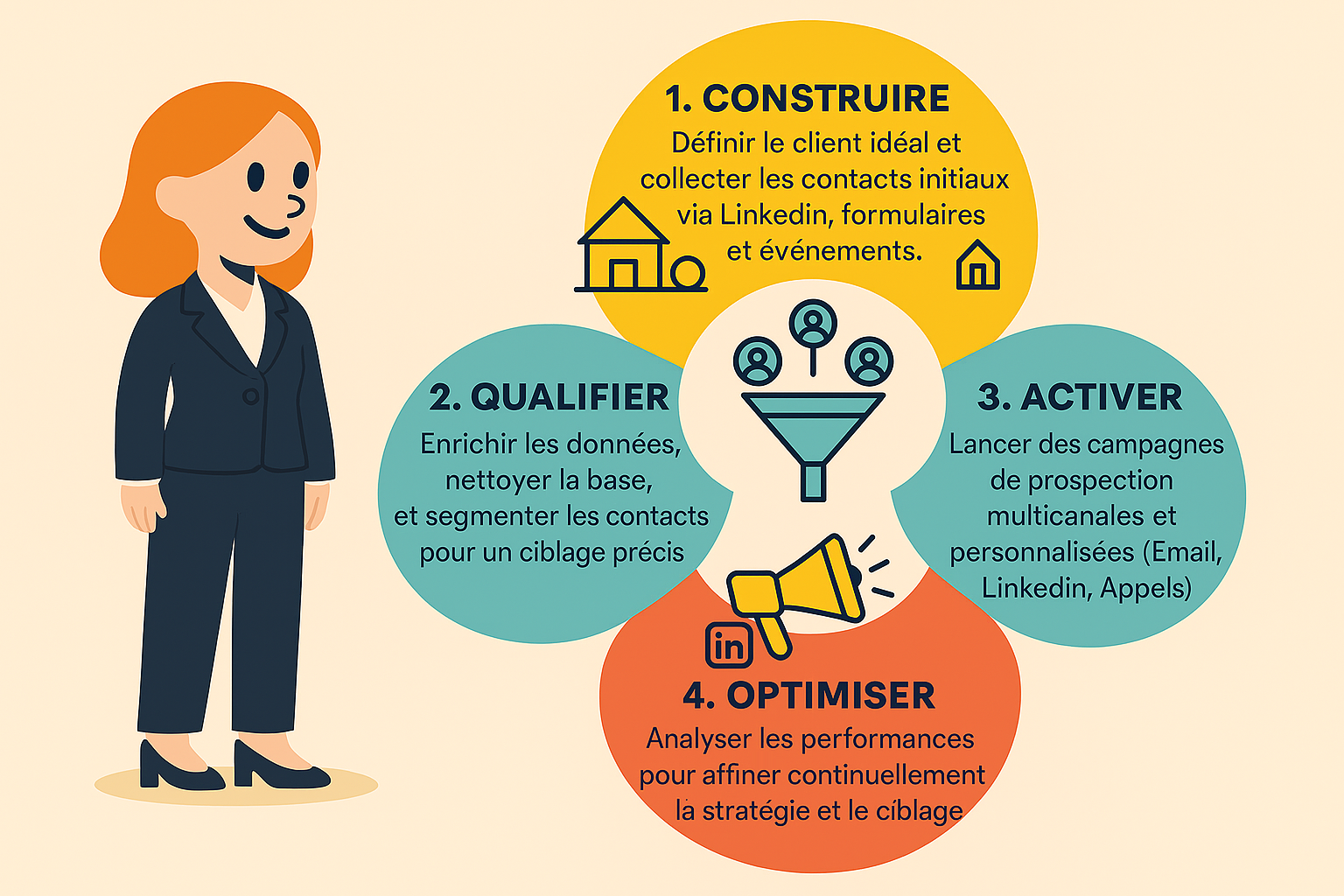Do your salespeople spend more time looking for contacts than selling? Not surprisingly, the average salesperson spends only 35% of his or her time on selling. This is often a sign that your prospect database is gathering dust. Yet without it, you can't hit the bull's-eye - it's the engine of your growth.
Clearly, a good prospecting database is your secret weapon. It helps you target the right people, at the right time, and turn "maybe's" into "yes's".
What is a prospect database?
👉 A prospect database is a structured reservoir of qualified information about your potential customers. It centralizes, in an organized way, data such as contact details, business sector, company size, interaction history, centers of interest and purchasing behavior. Thanks to this information base, your sales team can identify high-potential prospects more quickly and adapt their pitch to maximize impact.
In practical terms, a prospect database generally consists of three categories of data:
- Firmographic: company name, sector, sales, workforce.
- Demographic and behavioral: function, seniority, interactions (e-mail openings, downloads, web visits).
- Contact details: e-mail address, telephone number, LinkedIn profile or other professional networks.
By automating the collection and updating of this data, you can guarantee the freshness and reliability of your prospect file. A well-fed database feeds your marketing campaigns, alerts your CRM and optimizes every contact, for a measurable return on investment.
Objectives and concrete benefits
Your prospect database has a simple aim: to feed your growth engine with ultra-qualified contacts. By grouping together sector of activity, position, interaction history and signals of interest, you put your sales force and marketers in a position to act at the right time, with the right message.
What you gain in concrete terms :
✅ Precision: you eliminate off-target prospects and focus your resources on those who will generate real sales.
✅ Reactivity: as soon as a lead downloads content, visits a key page or interacts on LinkedIn, you trigger a personalized action that maximizes opens and appointments.
How to build a prospect database 4 steps

1. Define your perfect customer (ICP)
Before you even start looking for a contact, ask yourself this question: what does my customer persona look like? This is your Ideal Customer Profile (ICP). Sector, size, location, tools used... Put it all down on paper.
With a clear KPI, every contact you add is a potential target. No room for chance.
2. Collect data
When it comes to collecting data, you have two options: public sources (LinkedIn, company websites) or paid databases. The aim is to find reliable data to get you started.
You can use LinkedIn Sales Navigator for fine-grained searches, then tools like Kaspr or RocketReach to extract contact details. For French companies, a free resource like INSEE's SIRENE database is a good place to start.
3. Organize your database
Once you've got your data, it's time to organize it. Segment your contacts so you can personalize your messages. Here's the key information you need:
👉 Contact info: name, position, direct email, phone number.
👉 Company info: name, sector, sales.
👉 Tech info: the software your prospect already uses (technographic data).
👉 Intent info: signals that they're ready to buy.
4. Clean, clean, clean
Cleaning up your prospect database isn't something you do once a year. It's an ongoing process. Eliminate duplicates, correct errors, update information. It's the key to prospecting that converts.
The requirements of a prospect database
Your database isn't just an Excel file: it must meet legal, technical and operational requirements to remain reliable and efficient. Here's how to structure your actions.
How to enrich and clean up your prospect database for maximum impact?
A simple contact list is fine. A list enriched with intelligent data is much better. Enrichment means adding value to your contacts for ultra-personalized approaches. It transforms your prospect database into a veritable war machine.
Tools like Dropcontact or Clearbit exist, but doing it in-house is often time-consuming and expensive. Why not stop rowing and let the experts do the work?
That's where Scalability comes in. The platform combines AI and human expertise to create your sales prospecting database. AI SDRs (Sales Development Representatives) identify, qualify and engage your prospects. Meanwhile, your sales reps do what they love: close deals.
Conclusion
A prospect database is the heart of your sales reactor. Building and maintaining it takes time, tools and know-how.
Outsourcing this work to Scalability turns a headache into a powerful engine for growth. You'll become more agile, more efficient and your pipeline will never be empty again.
So, are you ready to blow your quotas out of the water? 👉 Discover Scalability

